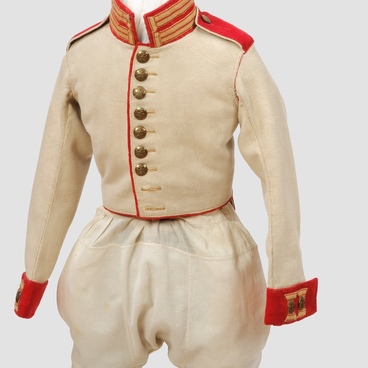On the front side of the commemorative token there are two ovals with images of the founder of the Russian circus, Akim Nikitin, both when he was young and in his advanced years. Two inscriptions have been preserved on the token’s reverse side: In fond memory of A.A. Nikitin’ and ‘40th anniversary of the Russian A.A. Nikitin circus’ Issuing the token was timed to coincide with both the 40th anniversary of the Russian circus and the 70th birthday of its founder, main producer, and director Akim Nikitin. The commemorative event was held in Moscow in 1913 in a building that held a permanent circus.
Akim Nikitin was the son of a former serf who became an organ grinder. Akim and his brothers, Peter and Dmitriy, joined the circus at an early age. They performed with their father first, and then they opened their own booth act, where they worked along with hired actors. Dmitriy performed as an athlete, Akim was a clown in a mask of Ivanushka the Fool, and Pyotr was a gymnast. The three of them performed a group acrobatic act, and gave puppet shows.
In 1873, circus performers Dmitry, Akim, and Pyotr Nikitin acquired a circus that was burned out, and had been owned by the Czech national Emannuel Beranek. The brothers acquired ownership rights to circus horses, horse fodder, circus costumes, and a circus tent that they then used to begin to travel around Russia. Prior to this, the owners and directors of circus troupes that toured Russia were foreigners exclusively. The first performance given by the Nikitins' Russian circus took place at the Christmas fair in Penza. In the Nikitins’ circus, clowns performed, risky gymnastic numbers were showcased, trained horses, camels, Andalusian bulls, and bears came out onto the arena. In 1876, the Nikitin brothers opened the first Russian stationary circus in Saratov. From the mid-1870s, they began to build stationary circuses in other large cities: Penza, Kazan, Nizhniy Novogorod, Tbilisi, and Kiev.
In 1890, the brothers built their own two-story mansion in Saratov at the corner of Nemetskaya and Volskaya streets. This house is still considered one of the most beautiful buildings in the city. There is a memorial plaque on it in honor of the founders of the Russian circus. The Saratov circus was named after the Nikitin brothers.
Akim Nikitin was the son of a former serf who became an organ grinder. Akim and his brothers, Peter and Dmitriy, joined the circus at an early age. They performed with their father first, and then they opened their own booth act, where they worked along with hired actors. Dmitriy performed as an athlete, Akim was a clown in a mask of Ivanushka the Fool, and Pyotr was a gymnast. The three of them performed a group acrobatic act, and gave puppet shows.
In 1873, circus performers Dmitry, Akim, and Pyotr Nikitin acquired a circus that was burned out, and had been owned by the Czech national Emannuel Beranek. The brothers acquired ownership rights to circus horses, horse fodder, circus costumes, and a circus tent that they then used to begin to travel around Russia. Prior to this, the owners and directors of circus troupes that toured Russia were foreigners exclusively. The first performance given by the Nikitins' Russian circus took place at the Christmas fair in Penza. In the Nikitins’ circus, clowns performed, risky gymnastic numbers were showcased, trained horses, camels, Andalusian bulls, and bears came out onto the arena. In 1876, the Nikitin brothers opened the first Russian stationary circus in Saratov. From the mid-1870s, they began to build stationary circuses in other large cities: Penza, Kazan, Nizhniy Novogorod, Tbilisi, and Kiev.
In 1890, the brothers built their own two-story mansion in Saratov at the corner of Nemetskaya and Volskaya streets. This house is still considered one of the most beautiful buildings in the city. There is a memorial plaque on it in honor of the founders of the Russian circus. The Saratov circus was named after the Nikitin brothers.



